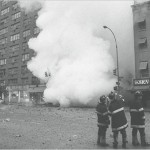History of Urban Logic
History of Urban Logic
The Early Years (1990s) – Thinking Spatially
Urban Logic started as a finance lawyer’s quest to prevent and recover from extreme events.
How It All Started
The catalyst for creating Urban Logic was the August 1989 Con Edison steam pipe explosion that sprayed 220 pounds of asbestos wrapping from a ruptured 135-year old steam pipe in New York City’s historic Gramercy Park, killing three people, making hundreds homeless during a nine-month cleanup, and causing upwards of $70 million in damage. A Con Ed work crew re-pressurizing the pipe at 20th Street and Third Avenue was unaware of the City’s Water Department crew draining water at 18th Street and Irving Place, and that the water had pooled around the pipe at its most fragile moments.
Bruce Cahan (Urban Logic’s founder and CEO) lived at 32 Gramercy Park. As an evacuee, blown out of his apartment, Bruce wondered how the streets of New York could be made safe from explosion. Bruce knew that Con Ed and Water Department work crews needed a shared map to see their operations’ proximity in real time, and take precautions accordingly.
Mitigation, not Just Response
Each extreme event led creating options for prevention, mutual aid response and resiliency.
- Formed by Bruce Cahan and David Kuhns in April 1992, Urban Logic designed a financial structure for New York City to build and maintain a multi-agency digital map infrastructure from bedrock to the top of the World Trade Towers. We researched and found capital funding to pay for the “digital map utility,” as basic infrastructure for running the modern city. Now known as NYCityMap, Urban Logic fought to make the geospatial data available as a web service to the public free of charge, rather than sold as NYC City Planning’s Bytes of the Big Apple CDs then priced at thousands of dollars.
- Throughout the 1990s, our experiences from NYC scaled up nationally to help federal agencies (OMB, FGDC, OMB and USGS) align their investments in spatial readiness, so as to create a common view of regional needs, capacities and priorities.
- In 1999, Bruce Cahan (Urban Logic’s founder and CEO) testified at the first Congressional Hearing on community use, needs and funding gaps in acquiring geospatial technologies.
- In 2000, we convinced the federal Office of Management and Budget OMB to create a 49 state I-Team structure for integrated strategic planning and opportunistic funding for regions to create interoperable spatial readiness and public accountability.
September 11th 2001 World Trade Center Attacks
On September 11th Bruce Cahan was in his Midtown NYC office speaking with Doug Yoder (Environmental Coordinator for Miami-Dade County) when the terrorists attacked the World Trade Center. In the following months, Bruce assisted at the NYC Mayor’s Command Center, providing logistical support to find, use and disseminate fast changing spatial data and maps needed to secure, recover and rebuild Lower Manhattan.
9/11 significantly changed Urban Logic’s thinking about what cities need to be safer, equitable, sustainable and resilient. While cities need spatial readiness, markets need better ways to rate and reward sustainable and resilient urban environments. Terrorists exploited the post-war architecture of buildings sized out of all proportion to sustainable function in the urban built environment. The rate of re-building in urban settings lacked market drivers for sustainability and resiliency. Urban Logic set out to find more options.
Urban Logic Today
Today, Urban Logic is a portfolio of research and design projects aimed at enhancing urban sustainability and resiliency, primarily using the transitions in banking and finance, in order to move from analog camouflage money, to high-transparency, impacts-aware money.



